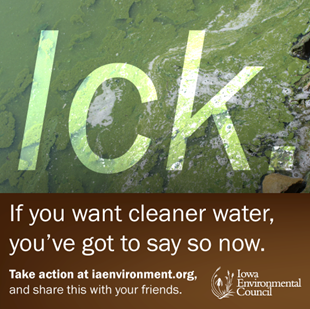Recently, at thedatabank we’ve been trying to focus on informing advocacy-based organizations about the importance of having a designated advocacy system that is both robust and integrated. To dive a little deeper into this topic, I’ve invited Matt Hauge of Iowa Environmental Council to talk about how their organization has used an advocacy platform to empower and advance IEC’s mission:
What has been your most successful advocacy campaign?
It’s probably not a surprise that our most effective campaigns are those that most match the interests of our supporters across Iowa. We have a 20-year legacy of working on clean water issues here and a strong base of support on those issues, so our strongest performing alerts deal with reducing water pollution and conservation action.
What did you do as an organization to contribute to the success?
We only send alerts on our core issues, and we take timing very seriously so our alerts connect well to news and policy events. We do our best to design our alert e-mails with users in mind. Some will see the clean water picture and big red action button and click through; others want more text or more information. We design with that in mind, while trying to keep the text light and concise.
Often times, when I launch an alert, I’m also launching a web of related material on social media, through e-mail, and on our website and blog. I map out the connections on a whiteboard in my cubicle to think about how pieces fit together as I write and post material.We also think about where alerts fit within other content we have produced on a topic. Did our e-Newsletter last month alert people this issue was coming up? Is there a blog post supporters can read for more details?
What is your one recommendation for organizations developing their advocacy agendas?
I think it’s so important to focus on how the alert will look to your supporters. I struggle with this because our team is extremely passionate and has deep knowledge about our issues, but our supporters’ engagement varies. Are we giving them the information they need to feel confident taking action with us—without too much detail? Your advocacy/database system can help you know.
So, my recommendation would be to set aside some time to really look at your performance data in order to continuously improve. I can’t always be perfect, but the data gives me ways of challenging my own assumptions.
What do you see as the biggest benefit of having an advocacy system to take action versus just using email?
For our supporters, the benefit is a clear boost in ease of use for taking action on issues they care about. Our organization is fortunate to have some of Iowa’s most committed environmental advocates in our community, but they’re busy, and the most committed folks are also buried in e-mail. We take pride in giving them opportunities to speak out on environmental issues in a way that’s timely and efficient so supporters feel like our actions are worth their time.
As a staff member, I can’t overstate the value of the data we receive through the system.
First, an advocacy system is essential if you really want to know what decision-makers your message is reaching. Tracking click-throughs or just asking advocates to report back won’t give you the same strategic perspective. (Believe me, I’ve tried.) We aren’t sending these alerts for fun—we want to understand the influence we are having.
Then second, we always want to learn more about our supporters and their interests. Having quality data about what motivates our supporters is valuable because it helps us tailor all our materials to their interests.
As a bonus, an alert system is very good for overall list growth. Action alerts are extremely timely messages on issues your supporters care about. That makes them very shareable and a good way to build your list through social recommendations.
Where do you think the future of advocacy is going?
On social media, or in e-mail, our supporters are bombarded with content all the time. There’s increasing pressure to find new ways to break through. For us, it’s meant streamlining our language and presenting a system that’s as easy to use as possible. It also means we’re working harder and harder to have a real-time connection with supporters as news breaks.
Advocacy is becoming more democratized, too. We had one of the earliest environmental action alert systems in Iowa, but now almost anybody can set up a petition online and be live in minutes. Just like Twitter changed the game for newspapers, technological advancements are changing the game for us. We have the advantage of deep expertise and credibility on our issues, and our challenge is to mobilize that faster than ever.
Matt Hauge is communications and outreach director for the Iowa Environmental Council, a coalition of individuals and organizations who support a safe, healthy environment and sustainable future for Iowa. Learn more about the Council at iaenvironment.org.
So what is the future of advocacy? In my next post, I’ll be tackling issues about the future of advocacy and out of the box ways of thinking about an advocacy campaign.



 thedatabank, gbc is technology for change, and we walk the talk.
thedatabank, gbc is technology for change, and we walk the talk. 

